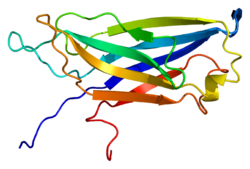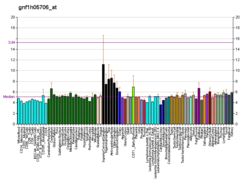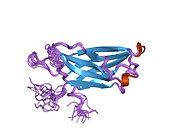| SYT4 |
|---|
 |
| Available structures |
|---|
| PDB | Ortholog search: PDBe RCSB |
|---|
|
|
| Identifiers |
|---|
| Aliases | SYT4, HsT1192, synaptotagmin 4 |
|---|
| External IDs | OMIM: 600103 MGI: 101759 HomoloGene: 7559 GeneCards: SYT4 |
|---|
| Gene location (Human) |
|---|
 | | Chr. | Chromosome 18 (human)[1] |
|---|
| | Band | 18q12.3 | Start | 43,267,892 bp[1] |
|---|
| End | 43,277,535 bp[1] |
|---|
|
| Gene location (Mouse) |
|---|
 | | Chr. | Chromosome 18 (mouse)[2] |
|---|
| | Band | 18 B1|18 17.75 cM | Start | 31,570,861 bp[2] |
|---|
| End | 31,580,459 bp[2] |
|---|
|
| RNA expression pattern |
|---|
| Bgee | | Human | Mouse (ortholog) |
|---|
| Top expressed in | - cerebellar vermis
- endothelial cell
- cerebellar hemisphere
- Brodmann area 23
- Brodmann area 46
- middle temporal gyrus
- superior frontal gyrus
- superior vestibular nucleus
- islet of Langerhans
- pons
|
| | Top expressed in | - cerebellar vermis
- ventral tegmental area
- pineal gland
- dorsomedial hypothalamic nucleus
- habenula
- ventromedial nucleus
- paraventricular nucleus of hypothalamus
- lateral hypothalamus
- barrel cortex
- dorsal tegmental nucleus
|
| | More reference expression data |
|
|---|
| BioGPS | 
 | | More reference expression data |
|
|---|
|
| Gene ontology |
|---|
| Molecular function | - calcium ion binding
- clathrin binding
- phosphatidylserine binding
- metal ion binding
- protein binding
- SNARE binding
- syntaxin-1 binding
- syntaxin binding
- syntaxin-3 binding
- protein homodimerization activity
- protein heterodimerization activity
- calcium-dependent phospholipid binding
| | Cellular component | - integral component of membrane
- intracellular membrane-bounded organelle
- membrane
- synapse
- synaptic vesicle membrane
- cell junction
- perinuclear region of cytoplasm
- neuron projection
- dense core granule
- cytoplasmic vesicle
- dendrite
- Golgi apparatus
- vesicle
- axon
- plasma membrane
- synaptic vesicle
- integral component of Golgi membrane
- integral component of synaptic vesicle membrane
- secretory granule membrane
- dense core granule membrane
- somatodendritic compartment
- neuronal cell body
- neuron projection terminus
- exocytic vesicle
- astrocyte projection
- microvesicle
- glutamatergic synapse
- integral component of neuronal dense core vesicle membrane
| | Biological process | - cell differentiation
- brain development
- positive regulation of dendrite extension
- negative regulation of vesicle fusion
- neurotransmitter secretion
- exocytosis
- vesicle fusion
- calcium ion-regulated exocytosis of neurotransmitter
- memory
- positive regulation of glutamate secretion
- regulation of dopamine secretion
- regulation of endocytosis
- regulation of vesicle fusion
- negative regulation of catecholamine secretion
- positive regulation of calcium ion-dependent exocytosis
- negative regulation of neurotransmitter secretion
- negative regulation of short-term neuronal synaptic plasticity
- vesicle fusion with vesicle
- secretory granule maturation
- negative regulation of protein secretion
- negative regulation of retrograde trans-synaptic signaling by neuropeptide
- regulation of calcium ion-dependent exocytosis
- negative regulation of calcium ion-dependent exocytosis
- trans-synaptic signaling by BDNF, modulating synaptic transmission
- vesicle-mediated transport
- calcium-ion regulated exocytosis
- cellular response to calcium ion
- regulation of presynaptic dense core granule exocytosis
- negative regulation of dense core granule exocytosis
- positive regulation of dense core granule exocytosis
- negative regulation of synaptic vesicle exocytosis
| | Sources:Amigo / QuickGO |
|
| Orthologs |
|---|
| Species | Human | Mouse |
|---|
| Entrez | | |
|---|
| Ensembl | | |
|---|
| UniProt | | |
|---|
| RefSeq (mRNA) | | |
|---|
| RefSeq (protein) | | |
|---|
| Location (UCSC) | Chr 18: 43.27 – 43.28 Mb | Chr 18: 31.57 – 31.58 Mb |
|---|
| PubMed search | [3] | [4] |
|---|
|
| Wikidata |
| View/Edit Human | View/Edit Mouse |
|

 1ugk: Solution structure of the first C2 domain of synaptotagmin IV from human fetal brain (KIAA1342)
1ugk: Solution structure of the first C2 domain of synaptotagmin IV from human fetal brain (KIAA1342) 1w15: RAT SYNAPTOTAGMIN 4 C2B DOMAIN IN THE PRESENCE OF CALCIUM
1w15: RAT SYNAPTOTAGMIN 4 C2B DOMAIN IN THE PRESENCE OF CALCIUM 1w16: RAT SYNAPTOTAGMIN 4 C2B DOMAIN IN THE ABSENCE OF CALCIUM
1w16: RAT SYNAPTOTAGMIN 4 C2B DOMAIN IN THE ABSENCE OF CALCIUM




















